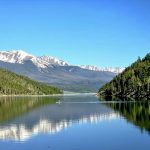Flight for Life helicopter rescues skier injured in avalanche on Grizzly Peak near Loveland Pass
A Colorado Avalanche Information Center report noted that Arapahoe Basin Ski Area, which is nearby Grizzly Peak, received 15 inches of snow in the 48 hours prior to the avalanche

Alpine Rescue Team/Courtesy photo
A Flight for Life helicopter airlifted a skier who sustained injuries on Sunday, April 20 in an avalanche on Grizzly Peak, according to the Alpine Rescue Team.
The all-volunteer rescue team wrote in a Facebook post that 24 members with six snowmobiles and a tracked UTV responded Sunday afternoon to Grizzly Peak — a 13,433-foot mountain that straddles Summit and Clear Creek counties on the Continental Divide in the Front Range — after a 911 caller reported that a skier suffered a severe knee injury in an avalanche.
The rescue team approached Grizzly Peak, which is located near Grays and Torreys peaks, two popular 14,000-foot peaks, from the top of Loveland Pass and from Stephens Gulch, the Facebook post states.
A brief window in the weather allowed a Flight for Life helicopter to get into the area and evacuate the patient to a higher level of medical care, according to the rescue team. No one was buried in the avalanche.

A field report filed with the Colorado Avalanche Information Center states that there were at least three skiers in the group. The wind slab avalanche occurred on the north side of the mountain and knocked a skier about 700 feet down the slope, injuring him, the report states.
Wind slab avalanches, which are common in Colorado, are formed by a cohesive layer of snow shaped by wind builds up over a persistent weak layer, according to the Colorado Avalanche Information Center.
The avalanche center says wind slabs are most reactive during a wind event and the first day or two after the wind event has ended. Wind slabs will usually stabilize in less than a week, so backcountry travelers can reduce their risk by waiting several days after a loading event, according to experts.
Arapahoe Basin Ski Area, which is nearby Grizzly Peak, reported about 15 inches of fresh snowfall in the 48 hours preceding the avalanche and the weather station at the ski area showed 5-15 mph winds with gusts of 25 mph preceding the side, the field report states.
The Colorado Avalanche Information Center wrote in a recent Facebook post that while the threat of triggering a massive avalanche has passed, there is still the potential to trigger other avalanches in the spring that can be consequential.

Support Local Journalism

Support Local Journalism
As a Summit Daily News reader, you make our work possible.
Summit Daily is embarking on a multiyear project to digitize its archives going back to 1989 and make them available to the public in partnership with the Colorado Historic Newspapers Collection. The full project is expected to cost about $165,000. All donations made in 2023 will go directly toward this project.
Every contribution, no matter the size, will make a difference.








